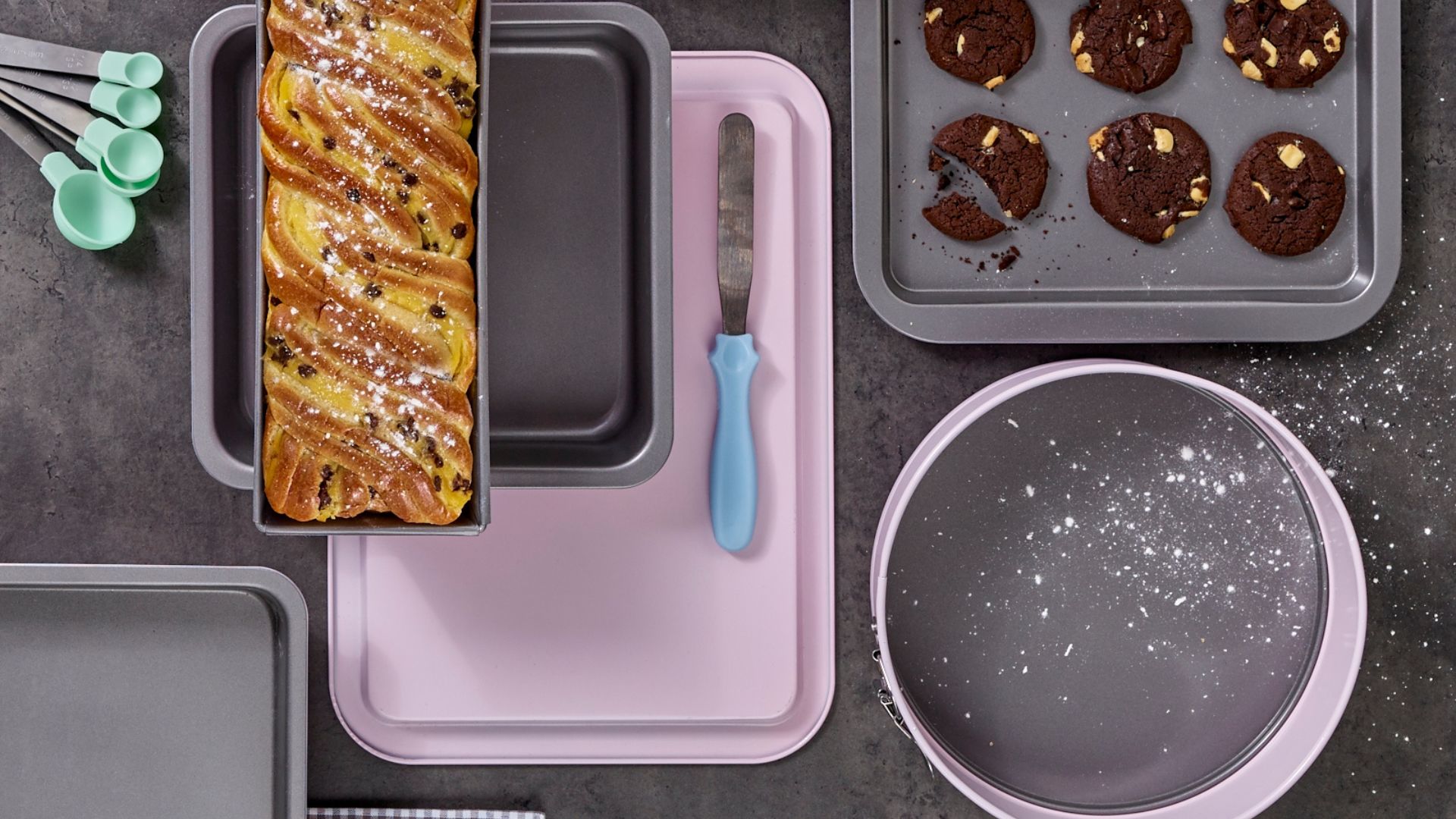 | ||
| Your browser is not supported. | ||
|
Please browse our site using any of the following options:
| ||
Seven Baking Essentials You Need To Know About

Cooking is an art, but baking is a science - having the right ingredients on hand, in the right amounts, is crucial to creating delicious cakes, slices and other delicious desserts. And most of the time, it's a lot more complicated than just adding flour, sugar, eggs and milk!
At Spotlight we know the importance of cooking with the right tools and ingredients, but with so many out there, it can be tricky to keep track of what's what. This blog aims to demystify some of the most confusing ingredients in baking - we'll go through what each is and how they are used, plus a quick summary of what essential baking equipment you should have in your kitchen if you love baking, or plan on starting!
Quick Links
- What Is Baking Soda?
- What Is Self-Raising Flour?
- What Is Castor Sugar?
- What Is Powdered Sugar?
- What Is Rice Flour?
- What Is Cream Of Tartar?
- What Is Tartaric Acid?
Essential Baking Equipment To Have In The Kitchen
If you need to stock up on baking equipment, here's a guide to what you'll need to start with.
Mixing Equipment
Mixing your ingredients is a crucial step of any baking process, and not mixing them well can lead to lumpy batter, an over or undercooked dessert or a dessert with undercooked chunks in it.
- A good stand mixer is a godsend for bakers, as it mixes batter much quicker than humans can do by hand and gives you a smooth, fluffy batter with little effort. If you don't have the space for a stand mixer, consider a handheld mixer instead! They are much smaller and come with fewer attachments but are just as effective at mixing ingredients.
- A silicone spatula is a multi-use tool that is easy to clean. Use a silicone spatula to fold in ingredients when mixing by hand, to remove batter from a bowl into a tin or to smooth icing and batter into a flatter surface.
Baking trays and tins
Using the right tin or tray to bake on will ensure your dessert is cooked through completely, without any burnt or soggy sides.
- A flat baking sheet is one of the cookie-baking essentials and can also double as a vegetable roasting tray when you're making savoury dinners.
- Baking tins come in many different shapes and sizes, from classic circles and squares to hearts, letters and numbers. Use them to create cakes and slices that will need space and support as they rise.
- Muffin and cupcake pans contain many wells in them all the same size and shape and are used to bake smaller cakes and treats that all need to be the same dimensions. Unlike other baking trays and tins, you can find these in silicone, which makes the baked goods easy to pop out when you're finished!
Other handy tools and accessories
Small but no less important, these baking tools are a must-have in any kitchen.
- Sieves are used to ensure any dry goods added to a bowl are fine and free from clumps. Using a sieve as you add things like flour and cocoa is the easiest way to prevent clumps in your batter - if you don't you will need to manually stir the batter to break up the lumps yourself.
- Measuring spoons and cups will ensure each ingredient is added in the correct amount, which is a vital step when baking. Too much or too little of a single ingredient can throw your whole project off balance, so use measuring cups and spoons to add the perfect amount every time!
Browse our full range of bakeware and kitchen utensils to get all the baking equipment you need.
1. What Is Baking Soda & What Is Bicarb Soda?
Baking soda, also known as bicarbonate of soda (bicarb soda) is a soft white powder that is technically a salt. This leavening agent will cause a foaming reaction in your batter that will cause it to rise and soften when baked, making it a necessity for many recipes.
But what is baking powder, and is it different to baking soda? Baking powder actually contains some baking soda, as well as an acid, which when combined with liquid creates the reaction we talked about above that causes your cakes to rise. Baking soda doesn't come with the acid included, so for the reaction to work it must be used in a recipe that has an acidic ingredient added to it. Ingredients like buttermilk, cocoa or lemon juice are all popular choices for recipes that also call for baking soda.
While both products are similar, you should try to have one of each on hand, as substituting one for the other isn't easy as you can't do it in a 1:1 ratio. Baking soda is much stronger than baking powder and can leave a sour, metallic taste in recipes it isn't called for, and you will need to add an acidic ingredient for the reaction to form.
Some recipes may call for both baking powder and baking soda - this will occur when the recipe already contains some acidic ingredient but not enough to cause it to rise with just baking soda alone.
2. What Is Self-Raising Flour?
Made up of one part regular flour, one part salt and one part baking powder, self-raising flour is a useful ingredient that will help ensure your baked goods always rise up evenly. Baked goods made with self-raising flour will have that lovely, airy texture you want in lighter desserts!
Self-raising flour should not be used in recipes that already call for a leavening agent like baking soda or baking powder, or in recipes used to make sourdough and other yeast-raised breads, as the yeast will do the leavening for you.
Did you know you can make your own self-raising flour? If you run out but still have your other baking ingredients on hand, it's simple to make. Simply whisk together 1 cup of soft, low-protein flour (all-purpose will also work but the end result won't be as tender), 1 ½ teaspoons of baking powder and ¼ teaspoon of fine salt. Store in an airtight container in a cool dry place for up to a year.
3. What Is Castor Sugar?
Also known as superfine sugar, castor sugar is a very fine granulated sugar that, due to the small size of the granules, dissolves very quickly when used in baking. This makes it ideal for recipes where the sugar must be fully dissolved so the dessert is smooth and creamy, like sponge cake, meringue, whipped cream, mousse and shortbread, as well as sweet sauces used for dipping or drizzling. It's not used to make icing or frosting though - that is powdered sugar, which we'll discuss next.
Castor sugar comes in white and brown forms. The white form is what is most commonly seen at supermarkets, and is a versatile sugar you can use in pretty much any dessert instead of regular granulated sugar. Brown castor sugar is unrefined and has a more intense, aromatic and caramel-like flavour that can add extra richness to your desserts and sauces.

4. What Is Powdered Sugar?
Also known as confectioners' sugar or icing sugar, this very fine sugar feels more like a literal powder than sugar! Some icing sugar also has a bit of cornstarch in it to prevent caking.
Using powdered sugar will change the texture of what you are baking. Using granulated sugar will create very small pockets of air in your dessert, leading to a lighter, airier texture that is great for creating crunchy desserts like cookies. On the other hand, using powdered sugar creates a dessert that is more dense, smooth and crumbly.
Because it dissolves so easily, powdered sugar is used to make all kinds of icing - hence the name icing sugar. Using normal sugar would result in a grainy icing, whereas powdered sugar creates a silky smooth ceiling every time! Use it for buttercream, frosting, glazes and royal icing.
5. What Is Rice Flour?
This gluten-free flour is made from either milled brown or white rice and has a very fine feel that makes it great for desserts but not as suitable for more hearty baked goods like bread. Because it doesn't have gluten, rice flour should not be used for making any baked goods that require gluten to rise.
Aside from gluten-free desserts, rice flour can also be used to make mochi, rice noodles, dumplings and delicious crunchy coatings for chicken and fish that are lighter and crisper than those made with wheat flour. It's a fantastic ingredient for gluten-sensitive and intolerant households, allowing everyone to enjoy some delicious baked good no matter their food allergies!
6. What Is Cream Of Tartar?
Another kind of leavening agent, cream of tartar is actually an ingredient that is leftover from the wine-making process, so actually comes from grapes! This powder is used to stabilise ingredients when whipping them, like egg whites for meringue, keeping them foamy without falling apart.
Cream of tartar also prevents sugar from crystalising, helping your cookies stay soft and chewy, instead of crunchy. Cream of tartar is often added to snickerdoodles for this reason! It can also give your desserts a tangy flavour.
Cream of tartar can also work as the acidic component if you are making your own baking powder. Combine ½ teaspoon of cream of tartar with 1/4 teaspoon of baking soda to make baking powder. It's also an ingredient in many homemade playdough recipes!
7. What Is Tartaric Acid?
Like baking powder and baking soda, tartaric acid and cream of tartar and different products with a few similarities. Like cream of tartar, it is a by-product of wine making. Tartaric acid is an acid that can be added to food to give it a more tangy, sour flavour, and it is often used in beverages, jams, jellies and lollies.
Tartaric acid can be mixed with potassium hydroxide to make cream of tartar - this means that tartaric acid on its own is much more acidic than cream of tartar! This acidity means you can use it to clean in a similar manner to baking soda.

Bake Like A Pro With Spotlight
We hope going over some of these important baking essentials and equipment has inspired you to get baking at home! You can find all the baking equipment you need at Spotlight, as well as some handy cake decorating tools and accessories - all for fantastic prices.
For more information on what cooking and baking essentials you need in the kitchen, read our buying guides on bakeware, kitchen tools and utensils and servingware. And for more baking ideas and inspiration, check out our blogs on how to host a high tea party, essential icing skills and how to create the ultimate birthday cake.




